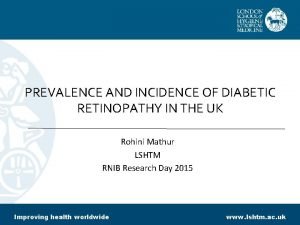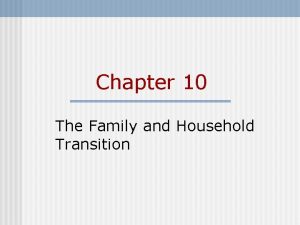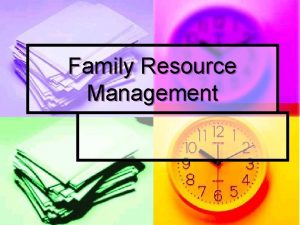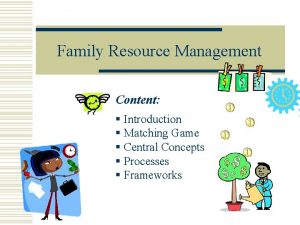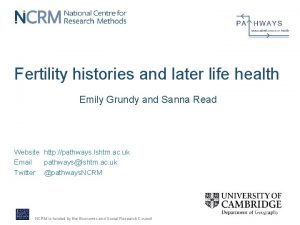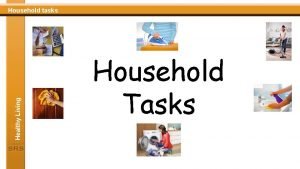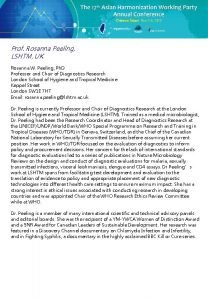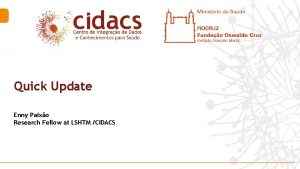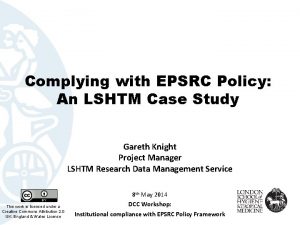Household and family resources Emily Grundy LSHTM Household
















- Slides: 16

Household and family resources Emily Grundy, LSHTM.

Household and family resources Background q Major changes in the living arrangements of older people and large declines in intergenerational coresidence. q Implications for support services needed for older people with disabilities, demands for housing of various types and household durables and consumables. q Also implications for well-being of older people q The Madrid Plan of Action adopted at the Second World Assembly on Ageing in 2002 called for research on the advantages and disadvantages of different living arrangements for older people.

Proportion (%) of elderly men and women living in households with two or more generations, England Wales, 1971 and 2001(private household population). Men Source: Analysis of ONS LS data. Women

Household and family resources Questions q What factors influence household patterns of older people are how are these likely to change? q Do family and household resources (numbers of close relatives; living arrangements) influence social participation, health and well-being? Overall aim q To improve our understanding of the determinants household type and household transitions (and, in other work packages, use this in projections, ) and improve our understanding of the implications of household, family and broader social support for wellbeing and receipt of help.

Household and family resources Data and methods 1) Analysis of demographic and other determinants of household type and household type transitions using the Office for national Statistics Longitudinal Study 2) Analysis of links between family availability, family contacts and contacts with friends and overall social participation using data from the English Longitudinal Study of Ageing. All analyses to examine socio-economic differentials and associations with indicators of health.

Household and family resources: Analyses based on ONS LS 1) Cross sequential analyses of ONS LS to illuminate trends and variations in intergenerational co-residence and proportions moving to live with relatives or to institutional care 2) More detailed analysis of household transitions 19912001 in ONS LS.

The ONS Longitudinal Study of England & Wales Census data for individuals with one of four birthdates enumerated at the 1971 Census (c. 1% of population) Maintained through addition of immigrants and new births with LS birth date Information from later censuses (1981, 91 & 2001) added Linked event data including death of the spouse of sample members and deaths of sample members.

Proportion (%) of people aged 65 and over who changed family/household type between censuses; 1971 -81; 1981 -91; 19912001 by age and family/household type at start of decade Source: Analysis of ONS LS data (earlier decades from Glaser & Grundy 1998)

Proportion (%) of people aged 65 and over who remained at same address & in same family/household type at succeeding censuses; 197181; 1981 -91; 1991 -2001 by age and family/household type at start of decade Source: Analysis of ONS LS data (earlier decades from Glaser & Grundy 1998)

% of women aged 65+ in 1991 in a communal establishment by 2001 and odds of transition to a communal establishment by parity. Odds ratios (95% CI) % changing from private household in 1991 to communal establishment by 2001 Source: Analysis of ONS Longitudinal Study data controlling for age, marital status, household type in 1991, health indicators and housing tenure.

Results of logistic regression model of proportions making a transition from a private to an institutional household 1991 -2001 OR 95% CI P Age 1. 14 1. 13 -1. 15 ** Gender (ref. male) 1. 14 1. 02 -1. 27 * Never-married 5. 92 4. 84 -7. 24 ** Wid. /div. 3. 63 3. 10 -4. 25 ** Not owner 1. 24 1. 13 -1. 15 ** Long term illness in 2001 (ref none) 9. 35 7. 63 -11. 46 ** Long term illness in 1991 (ref none) 1. 26 1. 14 -1. 38 ** Central 0. 93 0. 81 -1. 05 NS North 1. 15 1. 03 -1. 27 * Wales 0. 94 0. 77 -1. 15 NS Marital status in 2001 (ref. married) Tenure in 1991 (ref. owner) Region in 1991 (ref South) *P<0. 05; **P<0. 001 Source: Analysis of ONS Longitudinal Study data

Household and family resources: English Longitudinal Study of Ageing (ELSA) Two waves of data in 2002 and 2004 (third wave should be available within timescale of project) Cross-sectional dataset of population aged 60+ in Wave One – 7146 people Longitudinal dataset of population aged 60+ in Wave One and present at Wave Two – 5443 people

ELSA This model controlled for gender, age, smoking, wealth, housing tenure, contact with relatives, contact with friends, membership of social organisations and self-rated health status

ELSA This model controlled for gender, age, contact with relatives, contact with friends, membership of social organisations, health status at wave one, presence of depression at wave 1

Household and family resources: timescale Most primary analysis 2007 -8 (12 months of R. A. available) Interactive input projection models throughout. Suggestions appreciated.

ELSA This model controlled for gender, age, smoking, wealth, housing tenure, contact with relatives, contact with friends, membership of social organisations and self-rated health status
 Rohini mathur lshtm
Rohini mathur lshtm Sprague grundy
Sprague grundy Vec grundy va
Vec grundy va Paul grundy md
Paul grundy md Miss grundy’s new lesson plan
Miss grundy’s new lesson plan Grundy shirley
Grundy shirley Solomon grundy chant
Solomon grundy chant Sofia khetib grundy
Sofia khetib grundy Family and household transition
Family and household transition Difference between transforming and transformed resources
Difference between transforming and transformed resources Fixed resources definition
Fixed resources definition Jane eyre family tree
Jane eyre family tree Renewable vs nonrenewable resources worksheet
Renewable vs nonrenewable resources worksheet Family and resource management
Family and resource management Family resources
Family resources Conjugal family
Conjugal family Useful and harmful materials at home pictures
Useful and harmful materials at home pictures
